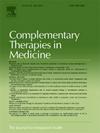经皮耳迷走神经电刺激治疗稳定症状性慢性心力衰竭的临床效果-一项初步研究
IF 3.5
3区 医学
Q1 INTEGRATIVE & COMPLEMENTARY MEDICINE
引用次数: 0
摘要
慢性心力衰竭(CHF)的特点是迷走神经活动的自主不平衡和交感神经活动的增加。低水平经皮耳迷走神经刺激(Ta-VNS)可能是CHF患者的一种安全的补充治疗选择。方法在这项随机临床试验中,共有13名诊断为CHF且射血分数降低的患者被随机分为两组,一组接受低水平Ta-VNS,电极应用于耳三角窝(振幅1 mA,频率1 Hz,持续40 min,然后休息20分钟),另一组接受假干预。主要终点是在心脏病筛查和闭诊期间评估的6分钟步行距离的增加。次要终点包括纽约心脏协会(NYHA)分级评估、体检、心电图和血液n端前脑利钠肽(NT-proBNP)和c反应蛋白(CRP)的采样。在筛查时进行超声心动图检查,并在闭诊时评估不良事件。结果12例患者完成试验。经皮耳迷走神经刺激组6分钟步行距离增加101.1(94.6)米,假干预组6分钟步行距离增加7.2(41.8)米(p = 0.04)。至于次要结局参数,包括CRP和NT-proBNP,两组间无差异。未观察到不良事件。结论在CHF患者中,Ta-VNS可有效改善6分钟步行距离,而在假干预组无此效果。在更大的患者群体中进一步调查这一发现可能会引起人们的兴趣。本文章由计算机程序翻译,如有差异,请以英文原文为准。
Clinical outcome of electrical transcutaneous auricular vagal stimulation in patients with stable symptomatic chronic heart failure - A pilot study
Introduction and aim of study
Chronic heart failure (CHF) is characterized by an autonomic imbalance of vagal activity and increased sympathetic activity. Low-level transcutaneous auricular vagus nerve stimulation (Ta-VNS) may be a safe complementary treatment option for CHF patients.
Methods
In this randomized clinical trial, a total of 13 patients with diagnosed CHF and reduced ejection fraction were randomized to receive either low-level Ta-VNS with electrodes applied in the triangular fossa of the ear (amplitude 1 mA, frequency 1 Hz for 40 min, followed by a 20-minute break) or sham intervention.
The primary endpoint was an increase of 6-minutes walking distance assessed during cardiological screening and closing visits. Secondary endpoints included assessment of New York heart association (NYHA)-classification, a physical examination, electrocardiogram and blood sampling for n-terminal pro-brain natriuretic peptide (NT-proBNP)and C-reactive protein (CRP). Echocardiogram was performed at screening and adverse events were assessed at the closing visit.
Results
A total of 12 patients completed the trial. 6-minute-walking-distance increased by 101.1 (94.6) metres in the transcutaneous auricular vagal nerve stimulation group, and by 7.2 (41.8) metres in the sham intervention group (p = 0.04). Concerning the secondary outcome parameters, including CRP and NT-proBNP, no difference was observed between groups. No adverse events were observed.
Conclusion
In patients with CHF, Ta-VNS effectively improved 6-minutes walking distance while no such effect was observed in the sham intervention group. Further investigation of this finding in a larger patient collective might be of interest.
求助全文
通过发布文献求助,成功后即可免费获取论文全文。
去求助
来源期刊

Complementary therapies in medicine
医学-全科医学与补充医学
CiteScore
8.60
自引率
2.80%
发文量
101
审稿时长
112 days
期刊介绍:
Complementary Therapies in Medicine is an international, peer-reviewed journal that has considerable appeal to anyone who seeks objective and critical information on complementary therapies or who wishes to deepen their understanding of these approaches. It will be of particular interest to healthcare practitioners including family practitioners, complementary therapists, nurses, and physiotherapists; to academics including social scientists and CAM researchers; to healthcare managers; and to patients. Complementary Therapies in Medicine aims to publish valid, relevant and rigorous research and serious discussion articles with the main purpose of improving healthcare.
 求助内容:
求助内容: 应助结果提醒方式:
应助结果提醒方式:


